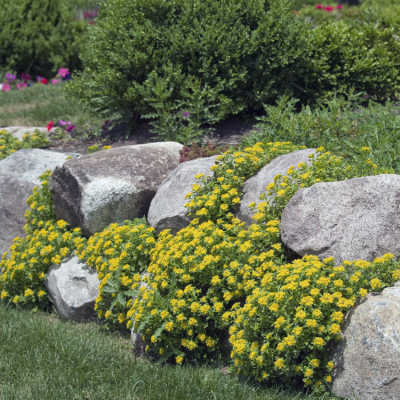Ground Covers vs Cover Crops
By Ashleigh Smith
Ground covers and cover crops are commonly confused with each other as they sound very similar. Here we are going to set the record straight on how these groups of plants are similar and, more importantly, how they are different. While they both belong in your garden, they serve different purposes. Simply put a cover crop is meant to rejuvenate your soil, while a ground cover is meant to keep your soil in place while also being attractive. You can find a list of recommended ground cover plants at the end of this article.
Cover Crops
Cover crops are used as a means of organically preparing your growing space for the upcoming season. As crops are grown, they harvest nutrients from the soil to build the fruits and vegetables you carry back to your kitchen. Constantly removing nutrients season after season can leave the soil deplete of important building blocks for healthy plant development.
Fertilizers could always be added to restore nutrients, but much more than the standard nitrogen, phosphorus, and potassium are lost. Using the organic practice of growing cover crops not only restores nutrients, but also increases the organic matter contents, reduces compaction, and improves the moisture management of your soil.
Cover crops are usually grown in the spring or fall for about 4-10 weeks depending on the cover crop. Before these plants have a chance to flower, they are mowed, cut, flattened, or killed by freezing temperatures. The plant matter that was grown then decomposes back into the ground. Cover crops, by nature, are short-term crops grown for long-term sustainable results. However, these results are only possible with continued use each year.

Garden Cover Crop Seed Mix
What Are Ground Covers?
Ground covers are a popular landscape uses for low-growing plants. When creating a landscape plan, the growth habit, color, scent, bloom time, and many more plant characteristics are taken into account to create a desirable space. With their low-growing and sometimes spreading habits, ground covers can fill a need within the realms of comfortable landscape designs while preventing erosion and suppressing weeds.
When considering a large area most people would prefer to have an attractively covered area of land, rather than exposed soil susceptible to creating dust and mud through the changing seasons. Groundcovers solve this problem by securing the soil and creating a more pleasurable experience within a space. Most ground covers are under a foot tall, although some may be taller depending on where you are growing and what its purpose is.
Unlike cover crops, ground covers are meant to be a long-lasting piece of your gardens and landscaping. Rather than being repetitively planted, they are maintained from season to season. Some of the most common groundcovers include grass and clover grown around your home, although there are more aromatic, colorful, and drought tolerant options available.

Spreading
A plant with a spreading habit can be valuable when trying to cover a large area, especially if that area is hard to maintain. These types of plants may be good for filling in around rocks, softening the look of a walking path, protecting soil around trees, or surrounding some stepping stones. Often times plants with this habit will have “carpet,” “creeping,” or “crawling” in their names. However, others may fall into this category as well.

Prevent Erosion
Do you live in an area that has experienced a lot of snow-melt or runoff this season? Plants can actually help reduce the damage of increased rains and flooding to a degree. Without plants, a bare soil area can only soak up so much water. Instead, this can lead to flooding as excess continues to flow over the soil surface. Plants help reduce flooding problems by slowing the speed of moving water and provide a route for the water to seep deeper into the soil.
While herbaceous, leafy plants do reduce problems with erosion, trees are the real champions in this scenerio. Their deep-growing roots help hold soil in place while allowing water to seep several layers deep into the ground. If you live on or near a slope, it would be wise to invest in some deep-rooted tree varieties. Typically the best trees for this purpose are slow growing and develop stable root systems.
The role of ground covers in erosion prevention come in for day to day rain and wind erosion events. During the time it takes trees to become established, smaller plants are also able to secure loose soil, increase the nutritional value of soil, improve soil structure, and add organic matter as compost. When your trees eventually reach greater heights, herbaceous ground cover plants can help protect the soil around the larger roots from washing away, help regulate soil moisture and temperature fluctuations, and create a more desirable space for you to spend time in.

Weed Suppression
Every gardener’s wish is for the weeds to magically disappear, right? Well, adding more plants can help you advance one step closer to your wish. As plants are grown together, light is blocked from reaching the soil. This helps reduce the number of weed seeds that can be germinated. With reduced access to light and increased competition for root space, weeds have a reduced chance of thriving. Whether you step in or not, something will likely be growing. It can be a shallow-rooted ugly weed, or it can be a beneficial and beautiful plant you will enjoy.